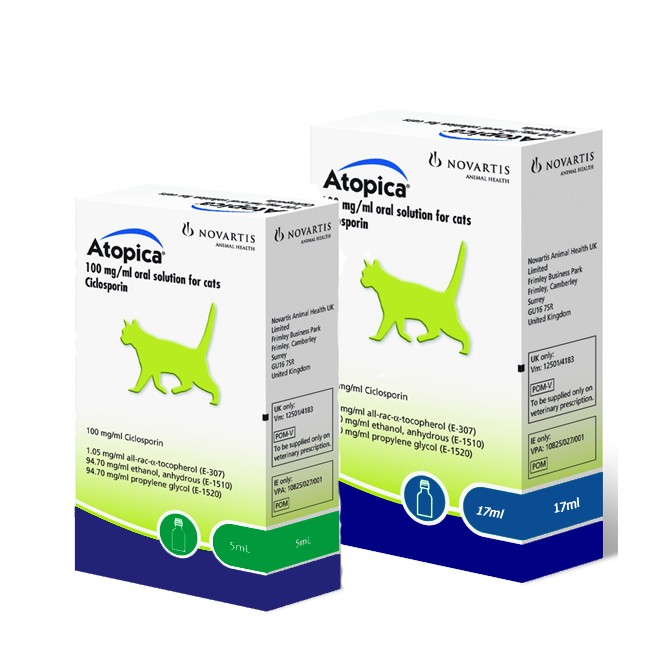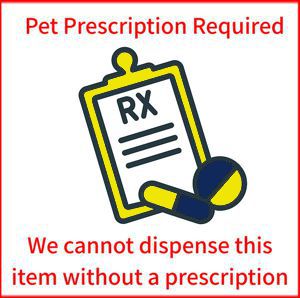
Atopica Solution for Cats & Dogs - 5ml
707776
Atopica Solution for Cats - 5ml - VET PRESCRIPTION REQUIRED
Product Features
- Pack Size: - 5ml
- Target Animal: - Cat (Feline)
- Pet Prescription Required?: - Yes (For UK Orders)
- Active Ingredient: - Ciclosporin
- Product Name: - Atopica Solution for Cats - 5ml
More Information
Description
This medication may only be supplied with a valid veterinary prescription issued by your vet. You should only purchase this item if you have or are in the process of arranging such a prescription. See information bar for further details.
Atopica Solution for Cats - 5ml
Atopica 100mg/ml cyclosporine A oral solution for cats presented in a multi-dose amber glass vial containing 5ml oral solution closed with a rubber stopper and sealed with a screw cap. One vial and a dispenser set (consisting of a dip tube and a 1ml syringe) packed in a cardboard box.
Uses
Symptomatic treatment of chronic manifestations of allergic dermatitis in cats.
Dosage and administration
The recommended dose of ciclosporin is 7 mg/kg body weight (0.07 ml of oral solution per kg). The frequency of administration should subsequently be reduced depending on the response.
Atopica oral solution should initially be given daily until a satisfactory clinical improvement is seen. This will generally be the case within 4-8 weeks. If an unsatisfactory response is obtained within the first 8 weeks, the diagnosis and treatment should be re-evaluated.
Once the clinical signs of allergic dermatitis are satisfactorily controlled, the product can then be given every second day. In some cases where the clinical signs are controlled with every second day dosing, the veterinary surgeon can decide to give the product every 3 to 4 days.
Atopica oral solution can be given either mixed with food or directly into the mouth. If given with food, the solution should be mixed with a small amount of food, preferably after a sufficient period of fasting to ensure complete consumption by the cat. When given directly into the mouth with the syringe, insert the syringe directly into the cat's mouth and deliver the entire dose. In the case the cat only partially consumes the product mixed with food, administration of the product with the syringe should be resumed only the next day.
Contra-indications, warnings, etc
Contraindications
Do not use in case of hypersensitivity to the active substance or to any of the excipients.
Do not use in cats infected with FeLV or FIV.
Do not use in cats with a history of malignant disorders or suspected malignancy.
Do not vaccinate with a live vaccine during treatment or with a two week interval before or after treatment.
Special precautions for use in animals
Allergic dermatitis in cats can have various manifestations, including eosinophillic plaque, head and neck excoriation, symmetrical alopecia and/or miliary dermatitis. Clinical signs of allergic dermatitis such as pruritus and skin inflammation are not specific for this disease and therefore other causes of dermatitis such as ectoparasitic infestations should be evaluated and eliminated. It is good practice to treat flea infestations before and during treatment of allergic dermatitis. A complete clinical examination should be performed prior to treatment. The immune status of cats to FeLV and FIV infections should be assessed before treatment.
While ciclosporin does not induce tumours, it does inhibit T-lymphocytes and therefore treatment with ciclosporin may lead to an increased incidence of clinically apparent malignancy. If lymphadenopathy is observed in cats while on treatment with ciclosporin, the animal should be evaluated for clinical disease and treatment discontinued if necessary.
Ciclosporin may cause elevated levels of blood glucose. The use of ciclosporin is not recommended in diabetic cats.
The efficacy and safety of ciclosporin has neither been assessed in cats less than 6 months of age nor weighing less than 2.3kg.
Cats that are seronegative for T. gondii may be at risk of developing clinical toxoplasmosis if they become infected while under treatment. In rare cases this can be fatal. Potential exposure of seronegative cats to Toxoplasma should therefore be avoided (eg keep indoors, avoid raw meat or scavenging). Ciclosporin was shown to not increase T. gondii oocyte shedding in a controlled laboratory study. In cases of clinical toxoplasmosis or other serious systemic illness, stop treatment with ciclosporin and initiate appropriate therapy. Any infections should be properly treated before initiation of treatment. Infections occurring during treatment are not necessarily a reason for drug withdrawal, unless the infection is severe.
Treatment with Atopica oral solution may result in decreased immune response to vaccination. It is recommended not to vaccinate during treatment or within a two-week interval before or after administration of the product.
Clinical studies in cats have shown that decreased appetite and weight loss may occur during ciclosporin treatment. Monitoring of body weight is recommended. In the event of persistent, progressive weight loss a complete clinical examination should be performed and treatment discontinued.
It is not recommended to use immunosuppressive agents concomitantly.
Special precautions to be taken by the person administering the veterinary medicinal product to animals
Wash hands after administration. In case of accidental ingestion, seek medical advice immediately and show the package leaflet or the label to the physician. People with known hypersensitivity to ciclosporin should avoid contact with the product.
Adverse reactions (frequency and seriousness)
The most frequently observed undesirable effects are gastrointestinal disturbances such as vomiting and diarrhoea. These are generally mild and transient and do not require the cessation of the treatment. Other undesirable effects observed in clinical studies included: lethargy, anorexia, hypersalivation, weight loss and lymphopaenia. These effects generally resolve spontaneously after treatment is stopped or following a decrease in dosing frequency. Side affects may be severe in individual animals.
Use during pregnancy, lactation or lay
The safety of the drug has neither been studied in male reproducing cats nor in pregnant or lactating female cats. In the absence of such studies in the cat, it is only recommended to use the drug in reproducing cats only upon a positive risk/benefit assessment by the veterinary surgeon.
In laboratory animals, at doses which induce maternal toxicity (rats at 30mg/kg BW and rabbits at 100mg/kg BW) ciclosporin was embryo-and foetotoxic, as indicated by increased pre- and postnatal mortality and reduced foetal weight together with skeletal retardations. In the well-tolerated dose range (rats at up to 17 mg/kg BW and rabbits at up to 30mg/kg BW) ciclosporin was without embryolethal or teratogenic effects. In laboratory animals ciclosporin passes the placenta barrier and is excreted via milk. Therefore treatment in lactating cats is not recommended.
Interaction with other medicinal products and other forms of interaction
Various substances are known to competitively inhibit or induce the enzymes involved in the metabolism of ciclosporin, in particular cytochrome P450 (CYP 3A 4). The compound class of azoles e.g. ketoconazole is know to increase the blood concentration of ciclosporin in cats, which is considered to be clinically relevant. Macrolides such as erythromycin may increase the plasma levels of ciclosporin up to twofold. Certain inducers of cytochrome P450, anticonvulsants and antibiotics (e.g. trimethoprim/sulfadimidine) may lower the plasma concentration of ciclosporin.
Ciclosporin is a substrate and an inhibitor of the MDRI P-glycoprotein transporter. Therefore, the co-administration of ciclosporin with P-glycoprotein substrates such as macrocyclic lactones could decrease the efflux of such drugs from blood-brain barrier cells, potentially resulting in signs of CNS toxicity. In clinical studies with cats treated with ciclosporin and selamectin or milbemycin, there did not appear to be an association between these drugs' concomitant use and neurotoxicity. Ciclosporin can increase the nephrotoxocity of aminoglycoside antibiotics and trimethoprim, the concomitant use of ciclosporin with these antibiotics is not recommended.
Particular attention must be paid to vaccination (see section "Special precautions for use").
Pharmaceutical precautions
Once broached, do not store above 30°C or below 20° C. Shelf-life of Atopica oral solution as packaged for sale; 36 months. Shelf-life after first opening the immediate packaging; 70 days, keep the bottle in the outer carton.
The product contains fat components from natural origin which can become solid at lower temperatures. A jelly like formulation may occur below 20°C which is reversible at temperatures up to 30°C. Minor flakes or a slight sediment may still be observed. However, this does neither affect the dosing nor the efficacy and safety of the product.
Disposal - Dispose of used packaging in the household refuse. Unused product should be returned to the veterinary surgeon.
Legal category
Atopica for Cats is a POM-V (Pet Prescription Required)





